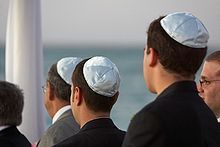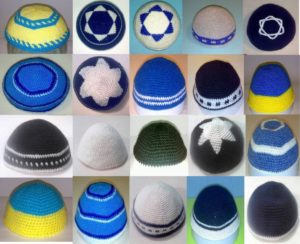The head of every devout Jew should be crowned with a skullcap - it is customary for Christians to remove their headdress when observing rituals. Wearing a piece of clothing that covers only the top of the head cannot have any other meaning than ritual.
What kind of headdress is a yarmulke?
 This round cap is so tiny that it barely stays in place and does not protect at all from the extremes of the weather: it will not save you from the sun, being without a brim, it will not hide you from the rain. By wearing it, Jews show humility and submission to God, while non-Jews show respect for the children of Israel.
This round cap is so tiny that it barely stays in place and does not protect at all from the extremes of the weather: it will not save you from the sun, being without a brim, it will not hide you from the rain. By wearing it, Jews show humility and submission to God, while non-Jews show respect for the children of Israel.
A similar item of clothing was known outside the land of Judea. For example, in the nineteenth century, a yarmulke was a part of a home set of clothes. A funny brimless cap was worn paired with a dressing gown or robe.
The svanka is also similar to a yarmulke - a thin gray felt cap, an element of the national costume of the Svans, representatives of a small people living in the Caucasus..
The Catholic pileolus is similar to the Jewish yarmulke: ministers of the Vatican cover the tonsure with it.
Curious! On the occasion of Pope Paul VI's visit to Israel in the 60s, photo reports appeared on newspaper pages. Under one of the photos, which captured the meeting of the head of the Vatican with the Israeli president, there was an explanation: “The Pope can be identified by his skull cap.”
Finally, there is the concept of an academic yarmulke - this is the type of headdress worn by scientists.
Yarmulka: meaning of the name and synonyms
Regarding the etymology of the word, data differ, and different sources refer to the following languages:
 Turkic;
Turkic;- Polish;
- Aramaic.
The least reliable version is of Turkic origin: the word “yagmurluk” proposed as a “core” means “raincoat”, which is contradicted by the functionality of an object that can barely stay on the head.
Supporters of the Polish version associate the name of the yarmulke with the concept of jarmułka, i.e. “hat”. And Hebrew experts, relying on popular interpretation, recall the phrase “yarei meeloka” (trembling at the sight of God).
Another name is bale. Also means dome.
Historical reference
The trace of the tradition of covering one's head when coming into contact with the forces of heaven leads back to hoary antiquity. Historians refer to two periods:
 before the era of the First Temple;
before the era of the First Temple;- entry of Judea into the Roman Empire.
The first version connects the custom with both practical and religious motives: one must hide from the sun so as not to get hot, and from the face of the Almighty - expressing submission. Only the tallit, a ritual veil, could be hidden properly. Subsequently, there was a transformation of the rule, which gradually acquired a symbolic character: for the conditional fulfillment of the requirement, a tiny bale is enough.
The second hypothesis connects the appearance of the kippah with the need not to differ too much from the Greco-Roman population, which influenced the appearance of both pro-Hellenic Jews and Orthodox Christians.
People don’t rack their brains over the history of the issue and explain everything simply: a bale is needed so that the Lord does not inadvertently hear stupid thoughts broadcast from an uncovered head.
Curious! Along with wearing a yarmulke, the hallmarks of a Jew are visiting the ritual springs of mikveh, in which one is washed from defilement, celebrating the Sabbath, and tsitses (bunches of thread) on clothes. A Jewish home is recognizable by the mezuzah attached to the doorpost - a piece of parchment with a prayer.
Connection with religion and customs
 Many Jews distinguished themselves by constantly wearing a yarmulke as a sign of constant pleasing to the Almighty, and this tradition has been alive for hundreds of years. Wearing a yarmulke is dictated by national custom rather than religious canons.. Covering the head during prayer was prescribed in ancient times: the Torah gives such instructions to the kohen, a special class of servants whose family dates back to Aaron himself, but there is no description of the required attire. The Talmud says nothing about this either.
Many Jews distinguished themselves by constantly wearing a yarmulke as a sign of constant pleasing to the Almighty, and this tradition has been alive for hundreds of years. Wearing a yarmulke is dictated by national custom rather than religious canons.. Covering the head during prayer was prescribed in ancient times: the Torah gives such instructions to the kohen, a special class of servants whose family dates back to Aaron himself, but there is no description of the required attire. The Talmud says nothing about this either.
Nevertheless, as a sign of continuous service, many Jews wore and wear a kippah constantly, emphasizing: the wisdom of the Lord is above the head of a mere mortal. The most devout believers consider it not pious enough to wear only yarmulkes under a hat or tallit. Non-Orthodox Jews (but conservatives!) hide the top of their heads in the synagogue and at meals. The Reformists have a special situation: they do not consider it necessary to cover a man’s head, moreover, not so long ago they would not have allowed him into another Reform synagogue wearing a kippah.. Now the traditions are returning.
The women's issue is also relevant in Israel.In ancient times, women did not wear kippahs - after getting married, a girl had to hide her hair from prying eyes with a blanket or scarf. Nowadays a skull cap can also be seen on a lady, although in orthodox circles they follow ancient precepts, hiding their hair under a scarf or wig.
Curious! The problem of dress code worried believers long before modern reformism. Back in the fourteenth century, the Polish rabbi Shlomo Luria had to answer the question: is it possible to eat with a “bare” head if it hurts? And the rabbi had to admit that there are no direct instructions in the scriptures on this matter, and you can even pray without hiding your head. However, the rabbi recommended not to enter into confrontation with a widely accepted tradition, so as not to receive the status of an atheist among his fellow believers. And for comfort, choose a softer material!
Types of headgear
One skull cap may differ from another in color, material and wearing style. Based on these signs, you can not only “calculate” an Orthodox Jew, but also his belonging to a certain direction of religion. A person wearing a kippah may be:
 Akshenaz: a cap of strict colors will give it away, more often in black and white;
Akshenaz: a cap of strict colors will give it away, more often in black and white;- Sephardim: these prefer multi-colored knitted or embroidered small skull caps;
- Hasidic: he will hide a kippah under his hat, and on great holidays he will put on a shtreiml - a ceremonial dress made of black velvet, trimmed with sable or silver fox tails.
Curious! “Weise Yarmulke” (simply a white kippah) hints: its owner is studying Kabbalah! And the seriousness of the appearance can be softened by a pompom.
How does a yarmulke stay on your head?
 Gravity is not a good helper for a light hat: traditional models made of heavy fabrics are now rarely worn. Hairpins can help out. Or is a popular way to wear yarmulkes under hats.
Gravity is not a good helper for a light hat: traditional models made of heavy fabrics are now rarely worn. Hairpins can help out. Or is a popular way to wear yarmulkes under hats.
Those who are not looking for easy ways are advised to select a kippah strictly according to size and are even advised to sleep in it for the night (if it stays in the right place, it means they didn’t miss the mark), which makes you think of a lively sense of humor. As well as the answers of the Jews themselves to the question of what a bald Jew should do. There are three of them:
- borrow a silicone elastic from a stocking from your wife;
- buy glue or double-sided tape;
- pick up the fallen pile, put it in your pocket and put on your cap.
Interesting facts about the yarmulke
 If you see a man wearing a headdress indoors, do not rush to accuse him of bad manners: what if he is a Jew? Then he pays respect to the mighty power that is above you! According to Jewish traditions, a headdress is required for males from the age of thirteen. It doesn’t matter what kind - hat, bandana, cap...
If you see a man wearing a headdress indoors, do not rush to accuse him of bad manners: what if he is a Jew? Then he pays respect to the mighty power that is above you! According to Jewish traditions, a headdress is required for males from the age of thirteen. It doesn’t matter what kind - hat, bandana, cap...- A goy who finds himself at a Jewish religious ceremony is not obliged to observe Jewish traditions in clothing. But maybe!
- Knitting yarmulkes is a common activity for rural women in the west of Jordan: the results of their labors are sold in Israeli markets. The price will depend on the specifics of the market: on the streets where there are obvious concentrations of tourists, the souvenir will be sold at a discount of fifty shekels. On the regular market it costs about five!
- Village women and city dwellers do not lag behind in the production of knitting needles: a woman with knitting needles can be seen on public transport and in front of an official’s reception, in a clinic and a lecture hall.
- A Jew can see the style and color of “his” skullcap a mile away. And he will never make a mistake!
- Little Red Riding Hood's name in Israel is Kipa Aduma.
- A Jewish atheist can be identified by the loudly pronounced phrase “Kipat ha Shamayim!”, meaning that he is covered by the vault of the sky. Literally it can be translated “Our kippah is the blue sky!”


 Turkic;
Turkic; before the era of the First Temple;
before the era of the First Temple; Akshenaz: a cap of strict colors will give it away, more often in black and white;
Akshenaz: a cap of strict colors will give it away, more often in black and white; If you see a man wearing a headdress indoors, do not rush to accuse him of bad manners: what if he is a Jew? Then he pays respect to the mighty power that is above you! According to Jewish traditions, a headdress is required for males from the age of thirteen. It doesn’t matter what kind - hat, bandana, cap...
If you see a man wearing a headdress indoors, do not rush to accuse him of bad manners: what if he is a Jew? Then he pays respect to the mighty power that is above you! According to Jewish traditions, a headdress is required for males from the age of thirteen. It doesn’t matter what kind - hat, bandana, cap... 0
0





